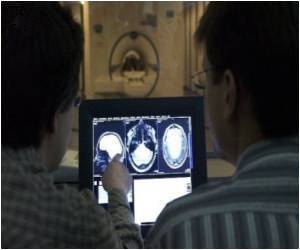Gliomas is the most common pediatric brain tumor found in childrens.

However, children who received radiation as part of their treatment had significantly lower long-term survival rates than children who were not radiated, researchers from Dana-Farber/Boston Children's Cancer and Blood Disorders Center report. These findings stand regardless of whether surgeons could successfully remove a child's entire tumor or only part of it, suggesting that the radiation itself may explain the difference.
The findings were published online by the journal Pediatric Blood and Cancer.
Delivery of radiation to children's developing brains has been linked to a number of adverse long-term effects, including cognitive development and endocrine function. While a number of major hospitals, including Dana-Farber/Boston Children's, have almost eliminated radiation in treating low-grade gliomas, the extent to which other institutions employ radiation varies, according to the study's senior author, Peter Manley, MD, of the Brain Tumor Center at Dana-Farber/Boston Children's.
"We found for the first time that once you survive your childhood with a low-grade glioma, you are not likely to die of that tumor as an adult," Manley said. "This is incredibly encouraging for patients and families. However, we also found some things that we are currently doing to treat low-grade gliomas, such as radiation, are increasing the rate of death later, so that as an adult you won't die of the tumor, but you may die from the treatment."
The data did not allow researchers to determine the precise mechanism driving the association between radiation treatment and reduced long-term survival (e.g., second cancers, other radiation-induced toxicities). However, given the excellent overall long-term survival findings among the patients studied, the team believes that doctors treating children for a pediatric low-grade glioma should make reducing long-term toxicity risk one of their primary concerns.
Advertisement
Low-grade gliomas—a family of non-malignant, usually non-aggressive tumors that includes pilocytic astrocytomas, diffuse astrocytomas and mixed gliomas— account for about 30 percent of all childhood brain tumors. Treatment typically consists of surgery and chemotherapy. Radiation, once a key component of therapy for these gliomas, has been falling out of favor since the mid-1990s, as it has for other childhood cancers such as Hodgkin's lymphoma and germ cell tumors.
Advertisement
Overall the prognosis for children with low-grade gliomas is quite good, with five- and 10-year survival rates approaching 90 percent. Until now, though, the long-term survival—20 years and beyond—of adult survivors has never been comprehensively studied. Manley and his colleagues found little drop-off in survival at 20 years post-treatment, with almost 90 percent of pediatric survivors still alive.
Strikingly, though, only about 70 percent of patients treated with radiation were still alive 20 years after treatment. Other factors that affected survival included tumor location (cerebellum or not), tumor type (pilocytic or not), aggressiveness of the tumor (grade 1 vs. grade 2), year of diagnosis (before or after 1990) and age at diagnosis (<2 years old). In the team's multivariate analysis, these other factors all had less of an effect on long-term survival than radiation.
"There is an impression that children diagnosed with anything more aggressive than a grade 1 tumor do poorly in the long term," said Manley, who also directs Dana-Farber Cancer Institute's Stop & Shop Family Pediatric Neuro-Oncology Outcomes Clinic, which focuses on survivorship issues. "However, we found regardless of whether the diagnosis is grade 1 or grade 2, children with low-grade gliomas still do well."
Source-Eurekalert















